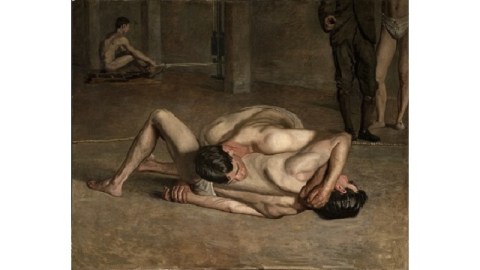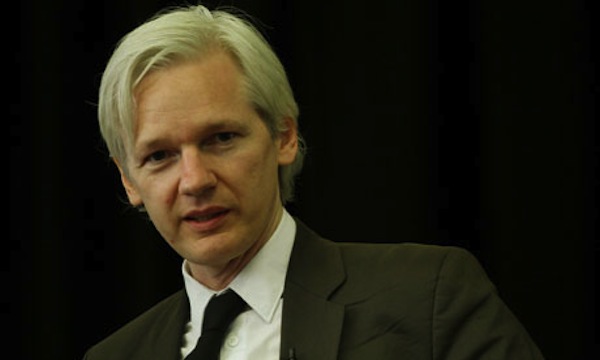Sports Illustrated: Thomas Eakins at the LACMA

While Thomas Eakins’ masterpiece The Gross Clinic undergoes a facelift on the east coast in the Philadelphia Museum of Art’s An Eakins Masterpiece Restored: Seeing The Gross Clinic Anew (my review here), Eakins’ art is being seen on the left coast in a whole new light as well. Manly Pursuits: The Sporting Images of Thomas Eakins at the Los Angeles County Museum of Art brings together 60 different works by Eakins related to sports—the first time that any museum has examined Eakins’ sports illustrations as the main focus of an exhibition. These sports illustrated illuminate not only Eakins’ approach to the subject, but also how sports began to take hold of the American public’s imagination in the late nineteenth century. It’s a glimpse at the very beginning of the fandom that would one day spawn ESPN and tailgating.
It’s hard to believe that no curator has ever attempted this kind of approach to Eakins’ art. An avid rower, biker, and outdoorsman, Eakins translated his love of leisure activity into images not only for his own pleasure, but also for the potential commercial interest such sporting images could generate. The LACMA’s acquisition of Eakins’ 1899 painting Wrestlers (shown) lit the fuse that eventually became this explosively exciting exhibition. Arranged chronologically from the 1870s up to 1899, Manly Pursuits features works dealing with rowing, sailing, hunting, coaching, swimming, boxing, and wrestling, including many of Eakins’ most iconic works.
Eakins’ 1871 masterpiece The Champion Single Sculls (Max Schmitt in a Single Scull)begins the parade of champions. Eakins knew Schmitt and often rowed the Schuylkill River with him. In fact, Eakins painted himself in the background, rowing away from the drifting Schmitt. As Alan C. Braddock points out in Thomas Eakins and the Cultures of Modernity, the Schuylkill teemed with pollution at the time, far from the idyllic blue upon which Schmitt sculls in the painting. That lack of realism in a painter hailed for his realism shows the true aim of Eakins’ sporting art—to create an idealistic view of human achievement, almost the Olympic ideal of athletic excellence.
Another masterpiece, A May Morning in the Park, or Fairman Rogers Four-in-Hand exemplifies Eakins’ interest in animals, especially horses and how they moved.As the exhibition points out, Eakins’ attempt to show the movement of the horses and wheels with photographic accuracy drew the ire of contemporaries, many of whom found such extreme realism to conflict with the romanticism of painting.
Finally, Swimming (from 1885) shows the “democratic” sport of swimming, one of the forms of exercise physicians at the time compelled urbanites to take up. The inclusion of Swimming, with its long critical reception as a homoerotic work, in an exhibition titled Manly Pursuits seems almost ironic. However, its controversies such as that connected with Swimming that make an examination of Eakins’ sporting pictures more than just fun and games and truly an academic and aesthetic exercise.
Perhaps the most interesting suite of paintings, however, are the wrestling and boxing pictures, including the LACMA’s own Wrestlers. These works, too, draw sexual considerations, but more importantly, they show how individual sporting images can transcend particular pursuits and speak of things beyond sports. Works such as Between Rounds and Salutat connect warriors of the ring with the warriors of gladiator days as depicted by Eakins’ teacher, Jean-Leon Gerome. Eakins’ boxers recreate the life-and-death drama of Ancient Rome but in the context of late nineteenth century America, the new rising “Rome” as the twentieth century lurked on the horizon.
Eakins belongs to the first rank of American artists. What makes him especially relevant to today is his eerily modern vision that predicted the role that sports would eventually play in American life as a metaphor for the struggles and triumphs of individuals within the group. Manly Pursuits: The Sporting Images of Thomas Eakins fills a long-standing gap in the study of Eakins and may lead more people to take another look at his art, which is about the twenty-first century as much as his own.
[Image: Thomas Eakins. Wrestlers, 1899]
[Many thanks to the Los Angeles County Museum of Art for providing me with the image above and press materials for Manly Pursuits: The Sporting Images of Thomas Eakins, which runs through October 17, 2010.]





